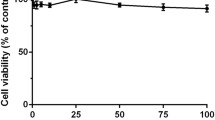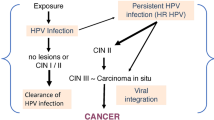Abstract
A subset of human papillomaviruses (HPVs), known as the high-risk types, are the causative agents of cervical cancer and other malignancies of the anogenital region and oral mucosa. The capacity of these viruses to induce cancer and to immortalize cells in culture relies in part on a critical function of their E6 oncoprotein, that of promoting the poly-ubiquitination of the cellular tumor suppressor protein p53 and its subsequent degradation by the proteasome. Here, we describe a cellular assay to measure the p53-degradation activity of E6 from different HPV types. This assay is based on a translational fusion of p53 to Renilla luciferase (Rluc-p53) that remains sensitive to degradation by high-risk E6 and whose steady-state levels can be accurately measured in standard luciferase assays. The p53-degradation activity of any E6 protein can be tested and quantified in transiently transfected cells by determining the amount of E6-expression vector required to reduce by half the levels of RLuc-p53 luciferase activity (50 % effective concentration [EC50]). The high-throughput and quantitative nature of this assay makes it particularly useful to compare the p53-degradation activities of E6 from several HPV types in parallel.
Access this chapter
Tax calculation will be finalised at checkout
Purchases are for personal use only
Similar content being viewed by others
References
Fu L, Van Doorslaer K, Chen Z, Ristriani T, Masson M, Trave G, Burk RD (2010) Degradation of p53 by human alphapapillomavirus E6 proteins shows a stronger correlation with phylogeny than oncogenicity. PloS One. 5
Lehoux M, D’Abramo CM, Archambault J (2009) Molecular mechanisms of human papillomavirus-induced carcinogenesis. Public Health Genomics 12:268–280
Camus S, Menendez S, Cheok CF, Stevenson LF, Lain S, Lane DP (2007) Ubiquitin-independent degradation of p53 mediated by high-risk human papillomavirus protein E6. Oncogene 26:4059–4070
Huibregtse JM, Scheffner M, Howley PM (1991) A cellular protein mediates association of p53 with the E6 oncoprotein of human papillomavirus types 16 or 18. EMBO J 10:4129–4135
Massimi P, Shai A, Lambert P, Banks L (2008) HPV E6 degradation of p53 and PDZ containing substrates in an E6AP null background. Oncogene 27:1800–1804
Scheffner M, Huibregtse JM, Vierstra RD, Howley PM (1993) The HPV-16 E6 and E6-AP complex functions as a ubiquitin-protein ligase in the ubiquitination of p53. Cell 75:495–505
Scheffner M, Werness BA, Huibregtse JM, Levine AJ, Howley PM (1990) The E6 oncoprotein encoded by human papillomavirus types 16 and 18 promotes the degradation of p53. Cell 63:1129–1136
Thomas M, Banks L (2005) In vitro assays of substrate degradation induced by high-risk HPV E6 oncoproteins. Methods Mol Med 119:411–417
Mesplede T, Gagnon D, Bergeron-Labrecque F, Azar I, Senechal H, Coutlee F, Archambault J (2012) p53 degradation activity, expression, and subcellular localization of E6 proteins from 29 human papillomavirus genotypes. J Virol 86:94–107
Gagnon D, Joubert S, Senechal H, Fradet-Turcotte A, Torre S, Archambault J (2009) Proteasomal degradation of the papillomavirus E2 protein is inhibited by overexpression of bromodomain-containing protein 4. J Virol 83:4127–4139
Acknowledgments
Development of this assay was supported by grants from the Canadian Cancer Society Research Institute and the Cancer Research Society.
Author information
Authors and Affiliations
Corresponding author
Editor information
Editors and Affiliations
Rights and permissions
Copyright information
© 2015 Springer Science+Business Media New York
About this protocol
Cite this protocol
Gagnon, D., Archambault, J. (2015). A High-Throughput Cellular Assay to Quantify the p53-Degradation Activity of E6 from Different Human Papillomavirus Types. In: Keppler, D., Lin, A. (eds) Cervical Cancer. Methods in Molecular Biology, vol 1249. Humana Press, New York, NY. https://doi.org/10.1007/978-1-4939-2013-6_8
Download citation
DOI: https://doi.org/10.1007/978-1-4939-2013-6_8
Published:
Publisher Name: Humana Press, New York, NY
Print ISBN: 978-1-4939-2012-9
Online ISBN: 978-1-4939-2013-6
eBook Packages: Springer Protocols




